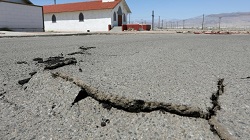[ad_1]
NAMIBIA is far from immune to earthquakes, says a geologist in the Ministry of Mines and Energy, Mako Sitali.
In fact, the largest seismic event ever recorded in Namibia was a magnitude 5,6 tremor that occurred in 2009 and a similar one recorded in 2021 in the Khorixas and Kamanjab areas.
Sitali was commenting on the two massive earthquakes that struck south-eastern Turkey and north-western Syria on Monday – the largest one a magnitude 7,8 earthquake – which left in their wake a swathe of destruction and death. “Earthquakes are a natural phenomenon and difficult to predict, therefore, we cannot tell if a magnitude 7 and above that has occurred in Turkey and Syria is likely to occur in Namibia,” Sitali said.
However, even with the largest tremor of magnitude 5,6 in 2009, no material damage was reported. This was attributed to Namibia’s low population density as the impact of earthquakes is naturally more severe in densely populated areas.
Sitali said the earth is dynamic and it is continuously moving, therefore, it is normal to experience earthquakes every now and then. Currently, a magnitude 7,8 earthquake followed by a magnitude 7,5 tremor killed thousands of people in south-eastern Turkey and northwestern Syria.
The death toll as a result of the earthquakes is over 16 000, with quakes and aftershocks continuing to topple buildings.
According to international media, the earthquake has its epicentre at Kahramanmaras, in Turkey’s Gaziantep province, about 50 kilometres from the border with north-west Syria.
The US Geological Survey reported that the area contains many buildings constructed of brick masonry or brittle concrete, making them extremely vulnerable tremors. Earthquakes and tremors recorded in Namibia are often recorded in areas of structural weakness in the earth’s crust. According to Sitali, current records indicate that while numerous earthquakes have been recorded countrywide, most earthquakes that have been recorded in Namibia have occurred in the Kunene, Khomas, Erongo and in the furthermost southern regions. “This is mainly due to the tectonic setting of these regions whereby there is existence of fault structures, which are basically weaker zones within the earth crust,” Sitali said. She said based on available data in the Namibian earthquake catalogue, earthquakes of a magnitude less than 3 happen on a weekly basis, while those of magnitude 3 and above happen monthly.
“Magnitude 4 may happen twice or thrice in a year and magnitude 5 and above happen in an interval of five to 10 years,” Sitali said. “The public is advised to familiarise themselves with the standard international safety measures in case of an earthquake.”
[ad_2]
Source link




